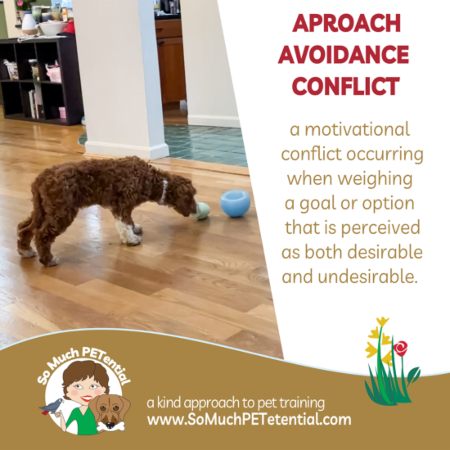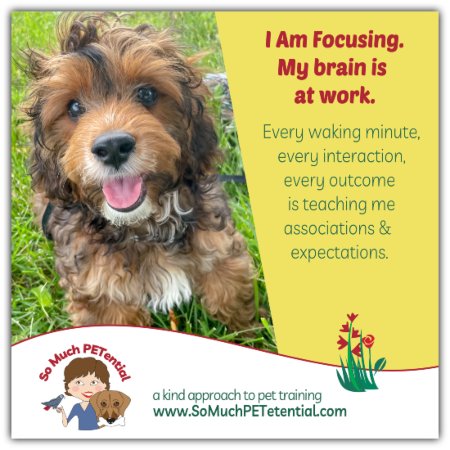The other day I visited the home of an Instagram phenom Harrison Ford (@HarrisonFordBulldog) and his newest housemate, Norman Peanut. There were some issues between adult dog and puppy, and they were looking for some guidance to help them get along. In this post, I share what I taught them and also have some tips for introducing a new puppy to your adult dog.
 Or, as Harrison shared on Instagram, ‘a lesson to Norman on how to NOT be a JERK’.
Or, as Harrison shared on Instagram, ‘a lesson to Norman on how to NOT be a JERK’.
It was an endearing, relatable way to express what was going on. The reality was Norman, like so many other young puppies, was doing things that Harrison did not appreciate. He was invading Harrison’s space. He was taking the family’s attention. He was barking at Harrison. He was playing with the dog toys. He was magnetized to his big buddy and that was causing a lot of stress for Harrison.
Understandably so.
Harrison responded by growling at Norman and even gently putting his mouth on the little ‘jerk’ as a way of letting Norman know his pushing the boundaries of personal space, and not listening to Harrison’s more subtle body language, were not welcome. Harrison’s escalated behavior did get through. Norman got the message clearly and backed off.
But Norman also was not listening to his humans, and so would not always come to them when they wanted to call him away.
After all, puppies have lots of needs to play and teeth and eat and run. They may have low thresholds for frustration. They don’t typically come to their new homes with good impulse control. They can play rough. They take up a lot of their families’ energy and attention. They may still have a lot to learn about understanding and responding appropriately to dog body language. To put it another way, they can be a downright, obnoxious pest to your adult dog. The relationship between a resident dog and puppy can be even more complicated if one or both of them has any kind of anxiety or fear.
When I arrived, Norman was in his playpen. He was either quietly resting, interacting with a toy or watching us while we talked. Harrison sat by his dad.
This was a great set up as it allowed Harrison to be separated from Norman, although in the same general space, and have positive interactions with his family. He was relaxed.
When it came time to bring Norman out, I practiced teaching him to sit, to pay attention to me and to come to me when I moved away – all in the near presence of Harrison. Especially with puppies, these lessons are made very fun incorporating yummy treats and play. I began using a lure to get Norman into a sit position and then kept feeding him to build value for that behavior. Quickly he began offering and staying in that position while Harrison was walking around and getting attention from his family. When Norman’s attention was somewhere else, I said his name, proclaimed ‘Yay!’ when he looked at me and then offered some personal play and treats when he came to me. I moved away from him and clapped my hands. When Norman came (running and bouncing) to me, I again, proclaimed ‘Yay’, patted him around his body and gave him treats.
Very quickly Norman lost interest in taking Harrison’s toys, getting into Harrison’s space, biting Harrison and any other unwelcome behavior. In fact, the two of them hung out side-by-side. Harrison’s mom told me that was the most relaxed she has seen him since Norman joined their family.
Since that day, the family has been careful to manage the interactions between the two (and giving them treats for ‘good’ behaviors) and as a result, and teaching Norman it is fun to listen to and hang out with his humans too. Norman is learning to respect Harrison’s space, and when he misses Harrison’s body language, the family redirects to allow Harrison to relax.
This is not the first time that I have been called to a home where there is conflict between the adult resident dog and the newer puppy.
YOU play an important role in helping their relationship to succeed
It is not enough to simply bring your puppy home, allow him full access to your resident dog (and lots of other space in your home) and hope that they will get used to each other. Your older dog needs to be able to feel safe (so does your puppy). Your older dog has a lot of change to adapt to, as does your puppy.
Early Introductions
First Impressions Matter. Just as with people, those first moments together can have big impacts. The best place to introduce your puppy to your resident dog is on neutral territory. It can be in a field or a neighbor’s yard or someplace else where there is opportunity for them to sniff. Doing this as a walk is good. You’ll want to keep the dogs moving without leash pressure (so having longer leashes for this is helpful) while you walk behind them. A comfortable harness is also helpful for this first introduction.
Your walk can even be from the end of your street back to your home. During this first encounter, allow them to sniff each other but really try to keep the focus on the walk to reduce the social pressure. Be watchful of your dog and puppy’s body language. You may need to do some redirecting if you see signs of fear or stress. If your puppy (or dog) gives a hard stare and/or stiffens his body, raises his hackles, charges, growls, lunges, cowers, tries to run away, or shows other signs of stress/fear/aggression, definitely move them apart. seek professional help from a positive trainer.
If you have more than one resident adult dog, make introductions one-at-a-time.
Coming Home
Be proactive when it comes to preventing resource guarding. Active supervision is imperative here. Dogs do not take kindly to puppies taking their things. Before you bring everyone home, take up things that your dog could potentially have a need to protect from the new ‘jerk’ on the block. This includes food, bowls, toys, bones, possibly beds. Watch your adult dog (s) carefully. If you see any of the body language I described above and the other does not heed that language, redirect your dog and/or puppy right away. An adult dog that just snickers at an oncoming puppy is often ok; however, if your dog lunges at your puppy or tries to bite your puppy that may likely be a bigger problem. Call a positive dog trainer for help.
Just a note here: this is more about dog insecurity and stress than about any kind of dominance going on.
You can proactively do activities with them, reinforcing each one for doing behaviors in proximity of the other. If you have two people there, one can also be giving treats to the adult dog while the other is doing things with the puppy. This will help to teach a positive association with the presence of the newcomer.
The Next Few Weeks
Allow your dog and puppy to get used to each other in their respective ‘safe places’. A pen like what Norman has, a crate, or a room behind a baby gate are all good choices for allowing your puppy to be in your (and your dog’s) vicinity while your adult dog can have recess from the new kid. (They should be confined in different rooms from each other when you are away or not present to supervise).
With the barrier between them, you can allow them to see, sniff and interact with each other (while you are supervising). If your adult dog looks toward your puppy with relaxed muscles, you can reinforce that with treats and or attention from you. If your adult dog (or puppy) charges the gate or shows any of the other stress signs I described above, give them farther distance from each other. It may be time to get a positive dog trainer involved.
When the two are out of confinement together, always keep a watchful eye. There are some dogs that instinctively know how to be gentle with a puppy but many do not. Thinking they will just figure things out for themselves and get a long eventually could be a big mistake. That is not to say that you should not allow your adult dog to give your puppy some mild signs of corrections (like a snicker, low growl, or air snap) but you want to be very careful not allow things to get more heated than that. Your adult dog needs you to be his advocate and your puppy could really be scarred (emotionally and physically) from a more aggressive interaction.
Another thing you can do is to teach your adult dog to move away from your puppy if he wants space, while also teaching your puppy to interrupt his own behavior or do more acceptable behavior when your adult dog indicates wanting distance.
Teaching them both to go to their own place can be helpful. Additionally, feeding them in separate bowls across the room or in another room or behind a barrier from each other while supervised is also good. (Avoid leaving food down for them to graze throughout the day.)
I want to also be the advocate for those extremely tolerant dogs who will ‘put up’ with a lot of unwelcome puppy behavior. These dogs need your support too. At some point, any dog can and will have a breaking point; and besides, it just isn’t fair to that dog.
Giving the relationship between your dog and puppy the best chance for success takes time. Unfortunately, I can not give you an exact time table as every relationship is different but in general, I suggest always having only supervised play time until your puppy is at least six months old. In that time, teaching them both behaviors like go to your place, recall, settling, and loose leash walking will be helpful.






